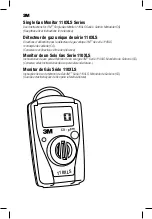
TABLE OF CONTENTS
GENERAL SAFETY INFORMATION
3
Intended Use
3
List of Warnings and Cautions
3
USE INSTRUCTIONS AND LIMITATIONS
4
Use For
4
Do Not Use For
4
General Description
4
SPECIFICATIONS
5
OPERATING INSTRUCTIONS
7
Turning Unit On and Off
7
Display Readings
8
Normal Operating Mode
8
Performing Self-test
8
Viewing Peak Levels
8
Calibration Reminder Function
8
Alarms
9
Viewing Alarm Set Points
9
Setting Alarm Levels
9
Alarm
9
TWA and STEL Alarm
9
Over Range Alarm
10
Low Battery Alarm
10
Alarm Mode Table
10
Calibration Verification Test and Calibration
10
Performing a Calibration Verification Test (Bump test)
11
Performing a Calibration
11
MAINTENANCE
12
Cleaning
12
Disposal
12
PRODUCTS, ACCESSORIES AND PARTS
12
WARRANTY
15
FOR MORE INFORMATION
15
GENERAL SAFETY INFORMATION
Intended Use
The M
™
Single Gas Monitor 0XLS Series is designed to continuously monitor the ambient environment
and notifiy the user if Carbon Monoxide (CO) levels reach the alarm set point for the monitor.
List of Warnings and Cautions within these
User Instructions
WARNING
Using a certified gas with a concentration other than the one listed for this instrument and sensor when
conducting a calibration or calibration verification test (bump test) will produce inaccurate readings. This
means that higher levels of the gas being monitored may be present and could result in over exposure
and
cause sickness or death
. For proper use, see supervisor or
User Instructions,
or call M in U.S.A.,
-800-4-460. In Canada, call Technical Service at -800-67-444.
Each person using this equipment must read and understand the information in these
User Instructions
before use. Use of this equipment by untrained or unqualified persons, or use that is not in accordance with
these
User Instructions,
may adversely affect product performance and
result in sickness or death.
This instrument helps monitor for the presence and concentration level of carbon monoxide gas. Misuse may
produce an inaccurate reading, which means that higher levels of the gas being monitored may be present
and could result in over exposure and
cause sickness or death.
For proper use, see supervisor or
User
Instructions,
or call M in U.S.A., -800-4-460. In Canada, call Technical Service at -800-67-444.
Use only for monitoring the gas which the sensor and instrument are designed to monitor. Failure to do
so may result in exposures to gases not detectable and
cause sickness or death.
For proper use, see
supervisor or
User Instructions,
or call M in U.S.A., -800-4-460. In Canada, call Technical Service at
-800-67-444.
Each time the unit is turned on, it performs a self-test, which activates the audible, vibratory and visual
alarms. If the self-test fails, or all the alarms do not activate, do not use. Failure to do so may adversely
affect product performance and
result in sickness or death.
Immediately exit any environment that causes an alarm condition on the monitor. Failure to do so may
result in sickness or death.
Do not cover or obstruct display, audible alarm opening or visual alarm cover. Doing so may adversely
affect product performance and
result in sickness or death.
Vibrator and LCD may not function effectively below –4 ºF (–0 ºC). Using the instrument below this
temperature may adversely affect product performance and
result in sickness or death.
The following steps must be performed when conducting a calibration or calibration verification test
(
bump test
) to ensure proper performance of the monitor. Failure to do so may adversely affect product
performance and
result in sickness or death.
– Calibrate prior to initial use.
– When performing a calibration or calibration verification test (bump test) only use certified
calibration gas at the required concentration level. Do not calibrate with expired calibration gas.
– A calibration verification test (bump test) should be performed before each use.
– If the instrument cannot be calibrated, do not use until the reason can be determined and corrected.
– Do not cover or obstruct display, audible alarm opening or visual alarm cover.
– Ensure sensor inlet is unobstructed and is free of debris.
– Ensure calibration hood is removed prior to use.
Do not attempt to clean the instrument by rubbing with a dry cloth. Cleaning with a dry cloth may generate
a static charge and result in an explosion if located in a hazardous environment.
































